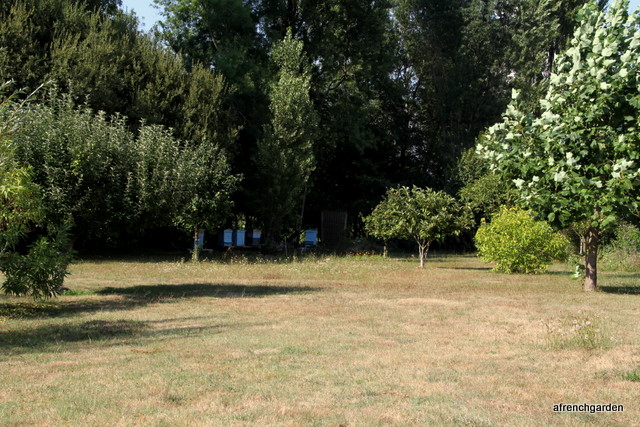 August has been hot and dry. Rain showers have passed to the north of us and to the south of us but we remain parched. The trees must be able to reach lower damper soil with their roots but even they are tiring. The leaves are starting to change to autumn colour because of the drought stress and the apples are falling.
August has been hot and dry. Rain showers have passed to the north of us and to the south of us but we remain parched. The trees must be able to reach lower damper soil with their roots but even they are tiring. The leaves are starting to change to autumn colour because of the drought stress and the apples are falling.
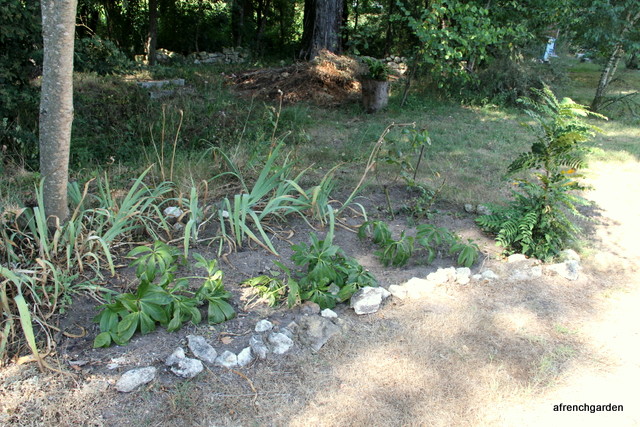
I have to water the young plants and the judicious watering is creating a well-weeded took as even the weeds are succumbing.
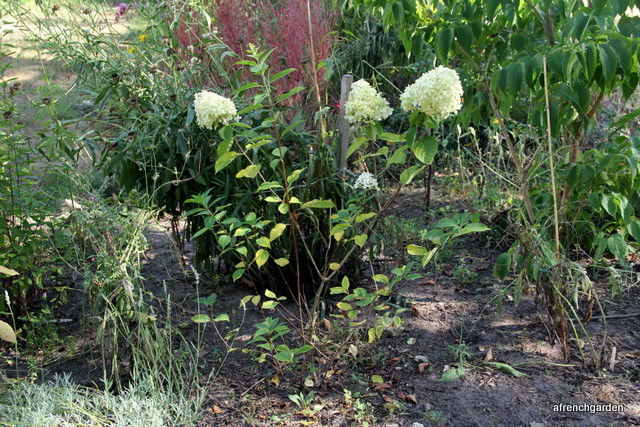
My “Savill Garden” hydrangea has survived and flowered for the first time but only the cared for plants can make it through the hot sun and dryness. Even the lavender requires some water.
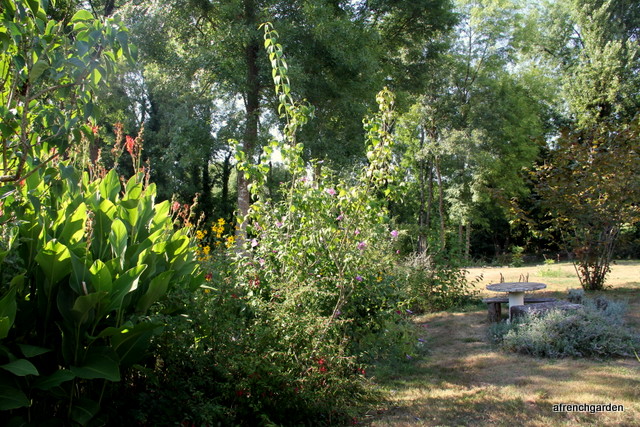
Only the Canna has survived and flourished without watering. I don’t actually like it and years ago I presumed I could kill it if I never watered it. Not so. Now I keep it as it provides a trouble free hedging and it is easily controlled by pulling out the new plants once a year either in autumn or spring.
A gold star goes to a tough, yellow flower that I was given, I think it must be a perennial sunflower. This on the other hand is a favourite as the bees adore it.
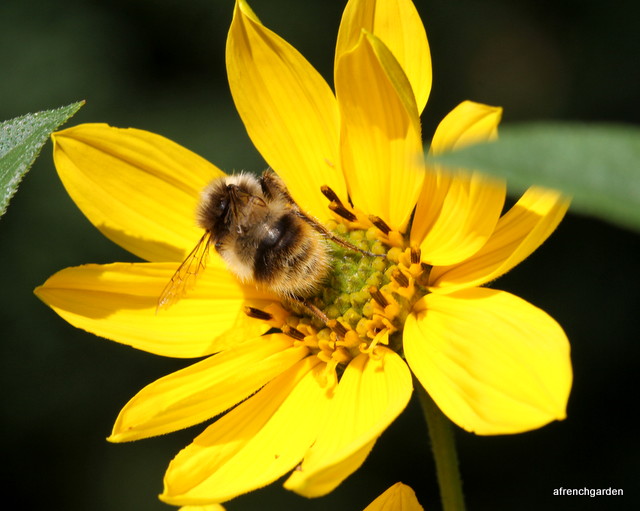
I could do with a help on the I.D. here. Even the bees are getting bleached in the sun! I would like to know if this is a Shrill Carder bumble bee or just a very bleached other carder.
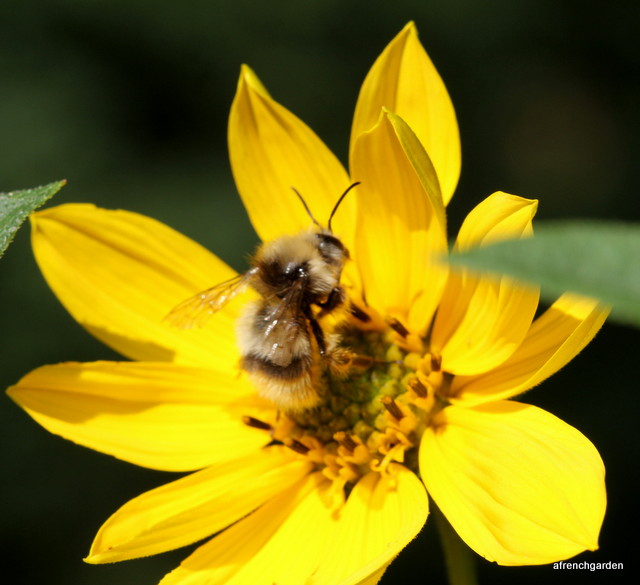
Here is a side shot if it helps.
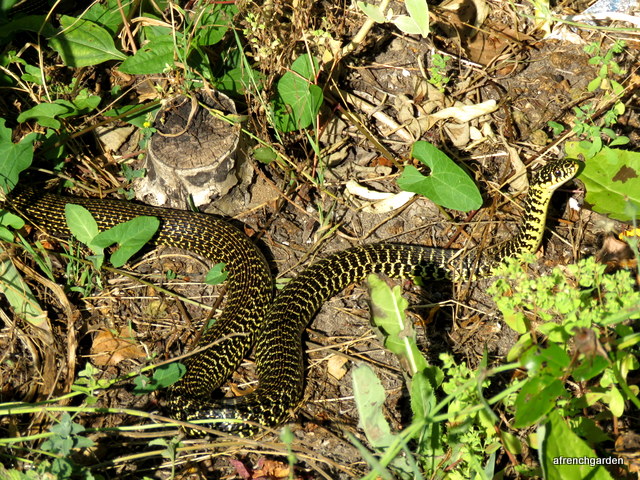
One creature that was enjoying a hot sunny spot in the garden was this Western Whip snake or couleuvre.

They are not venomous and very shy, not hanging around when disturbed. I was surprised, therefore, to see it later in a different part of the garden. Coincidently, it was near a hose each time.
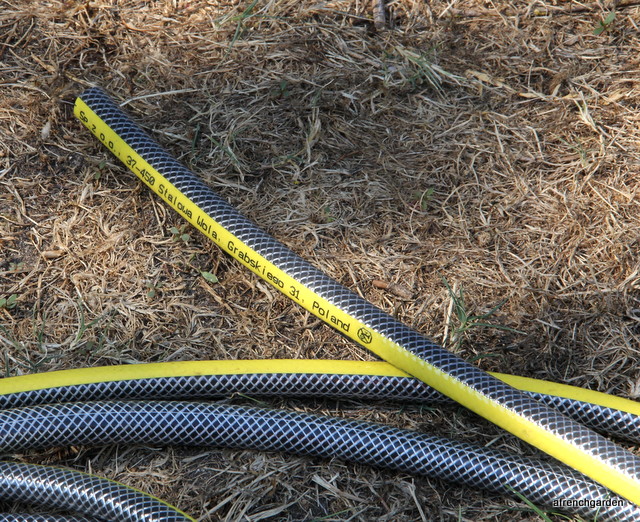
In view of the colour of our garden hose, I wonder if it was just looking for a friend?

Outside of the garden the wild mint is in flower and attracts loads of bees and butterflies.
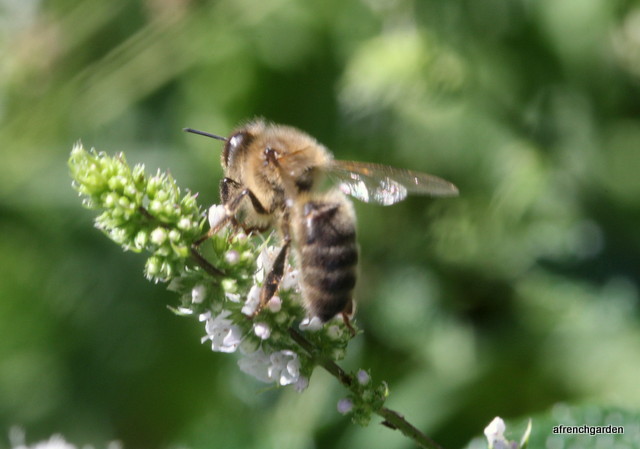
I have let our mint flower in the garden too and notice our bees on the flowers. Does this meant that our honey will have mint overtones?

The Gaura is the favourite flower of the honey bees in the garden at the moment. The pollen is all carried away by mid-morning but I notice the bees fill-up on the nectar while collecting the pollen.

I am fascinated by my Artemisia absinthium bush. This is the plant used in the production of absinthe and known commonly as Wormwood as it was used in the treatment of intestinal worms.
What fascinates me is that I never see an insect on it: not a fly, or bee or butterfly. Yet it has pleasant little yellow pom-pom flowers that remind me of Mimosa. It was at one time used for strewing on floors to keep insects away or for folding into materials to protect them from damage by mites.
I have tried rubbing it in my hands and it has a not unpleasant odour and I wonder how it would fare as an anti-mosquito treatment. I think I will cut the branches and try it in the cupboards this winter as an anti-moth remedy.
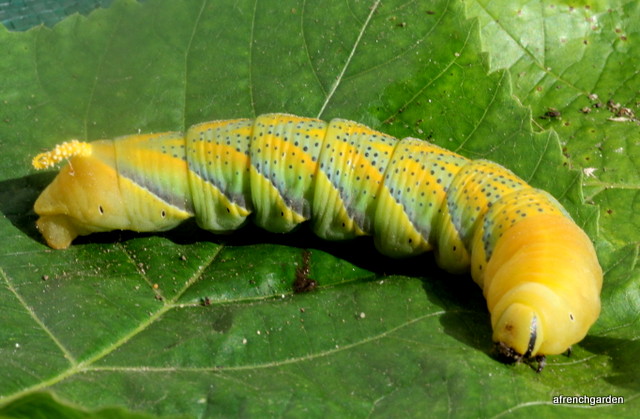
This caterpillar did not come from my garden. My neighbour Annie brought it down to me as she knew I would be interested. It was 12 cm. long and 2 cm. tall (?), a real chunky chappy. I recognised it as a Sphinx caterpillar but as it happened our beekeeper friend, Michel, was here too and correctly explained that these caterpillars grow into Death’s head hawkmoths; moths that love honey and can invade bee hives. I must admit I was a bit sceptical of moths attacking bee hives but check out https://en.wikipedia.org/wiki/Death%27s-head_hawkmoth.
Poor bees they have a lot to put up with!

I was interested in your conclusion about the snake as I too have often seen this snake lying alongside hose pipes. Your caterpillar is rather handsome isn’t he?
LikeLike
Interesting that you have seen it lying beside the hose too. More than a coincidence I think. Amelia
LikeLiked by 1 person
Yes I think that too.
LikeLike
Maybe your little snake was hoping to mate with your garden hose?😀 Not having a garden any more, sadly, had to leave a beautiful one behind in England, I so enjoy reading all about your own garden trials and tribulations, thank you.
LikeLike
I did not have a garden when I lived in Aberdeen and we chose a proxy garden in a castle nearby that we loved to visit. I forgot to mention that my little snake is about two metres long and I think it must have been lonely 🙂 Amelia
LikeLike
What did you do with the caterpillar? I’ve never come across the moth in a hive but would love to hear one, even if it was up to no good!
LikeLike
I get nervous just thinking about a moth going into a hive. I am afraid the caterpillar ended up as an additional treat for our patio visitors 😦 Amelia
LikeLike
Some fabulous pictures and sightings, Amelia. And your garden does indeed look like it could do with a real shower – we just had our son visit and we had 33 mm of rain overnight ….which when I checked up was the wettest 24 hours (let alone 12 hours) since January 27th. So even we’ve had it dry, but all things are relative…!! Wish I could check out the DHHM video. Do they escape damage from guard bees by emitting noises or pheromones? I seem to remember that in another case of caterpillars in ant nests, the caterpillar mimiced ant olfactory cues, but I might be mistaken.
Love the snake and pipe similarities! Well spotted.
Best wishes
Julian
LikeLike
It has been suggested that the moths can mimic the noises inside the bee hive and also the pheromones. With such a big moth, I can’t see the sound alone working, it must have some way to mimic or absorb the hive odours, I think. Your rainfall makes me envious, we have a possibility of some rain on Friday but before that very high temperatures are forecast. Amelia
LikeLike
Thanks for that Amelia, and good luck with the rain . Julian
LikeLike
I hope you see some rain soon. We’re in a severe drought here too, so I know what you’re going through.
LikeLike
Maybe a little on Friday, they say. The rain makes such a difference to the plants, I think we are all longing for it. Amelia
LikeLiked by 1 person
A beautiful caterpillar. It always seems the ugly ones become pretty butterflies and the pretty ones turn into insignificant coloured moths! Interesting that they like honey, and that they can squeak, according to the Wikipedia article. Hope you get some rain soon. We had more than our fair share until early August, so we probably got yours too!
LikeLike
I have always been a bit cool towards attacks by the caterpillars on my Brussels but that story made me nervous! Amelia
LikeLiked by 1 person
Thanks for sharing, and stay cool!
LikeLike
Our son arrives tomorrow and it is forecast to be 36 degrees Centigrade. I will try. Amelia
LikeLiked by 1 person
I think you are alright with B. sylvarum for that bumble bee. The pattern of hairs and bare bits looks right. B. pascuorum would have a series of narrower stripes of hairs alternating with bare in my opinion. Time of year is good for sylvarum too.
LikeLike
Thank you for that. I struggle with bumble bees despite seeing so many in the garden. Interestingly, another sighting I had with photographs which is a definite was taken at this time of year, or a little later, in my Heptacodium. Still, I do not see many. Amelia
LikeLike
Never thought I would feel sorry for a snake.
Good photos and it was interesting learning about the wormwood.
LikeLike
I think it must be an appealing reptile. 😉 Amelia
LikeLiked by 1 person
What a pity you can’t use the wormwood to keep the moths out of beehives. Hope it keeps the moths out of your cupboards. Wishing you rain but not so much that it spoils your son’s visit.
LikeLike
We do store frames with wax in them so we are going to use the wormwood to protect them. The weather has now been changed from rain to dry and temperatures around 35 degrees for the next five days. Luckily our son like the heat. Amelia
LikeLiked by 1 person
I am not a great fan of snakes but that one is an attractive fellow!
LikeLike
We see them regularly but not frequently and we enjoy having them in the garden to add to the variety. I think the shy, harmless animals have a special charm. Amelia
LikeLike
Fascinating pictures of the snake and the caterpillar. Fading is a big problem with bee ID at this time of year but I would go with you and Susan that it is B. sylvarum. Do you think that the other bumblebee is a B. pratorum worker?
LikeLike
Thanks for your confirmation of the B.sylvarum. I think the other bumble is a B. pratorum male because of the yellow tuft of hair on his head. They are much more numerous here in the spring but I think they keep on breeding with new queens. Amelia
LikeLike
What a handsome snake. I do hope he finds a real friend soon! And I hope you get some rain soon… it must be frustrating. Otherwise, your garden is looking just lovely.
LikeLike
Thank you, but still there is no rain forecast. It is getting monotonous. Amelia
LikeLike
I did wonder about a B.pratorum male but the ones I see here are much fluffier and have much more yellow including a yellow abdominal band. I had a look at some of my photos and I wonder if it might be a B.lapidarius male. The ones I see here have the tuft of hair on the forehead??
LikeLike
Thank you for that, Philip, it is a much more sensible suggestion as I have lots of B. lapidarius and even a nest in the garden. I don’t know why it did not click. I do miss not being able to chat to anyone about the bees but this is almost as good!
LikeLiked by 1 person
Thanks Amelia, how interesting to have a nest in your garden and see them going to and fro. I have to admit I feel very “at sea” with identification of most of the wild bees I see so its also very good for me to have a discussion. Last week I saw the first Lasioglossum I felt comfortable to give the name to, not the species, just the genus.
You might be interested in the BWARS Facebook page which I find quite educational just looking at the species people have seen around.
Are your ivy bees out yet?
LikeLike
Our ivy is not out yet! We are in the Lot at the moment and even here is dry. I did not know that BWARS had a Facebook page. I have not used Facebook for years but I do have an account, I must check it out. I am getting concerned about the drought continuing. The trees are drying out and I am even concerned it could affect the birds in the winter with less berries for them. Amelia
LikeLike
The snake courting the hosepipe really made me laugh!
LikeLiked by 1 person
So sad that you let your wonderful Death’s-Head Hawkmoth caterpillar become food…
the moth is as rare as hen’s teeth!! The tiny amount of honey that it would have nicked from your bees could surely have been spared… it doesn’t attack bees, just steals a bit of honey!!
Your action will have deprived others of seeing such a rare moth.
LikeLike
Oh dear, I did not realise it was rare 😦 I try to let everything be and keep a balance but I was panicked. Thank you for letting me know. Ignorance is our worst enemy. Amelia
LikeLike